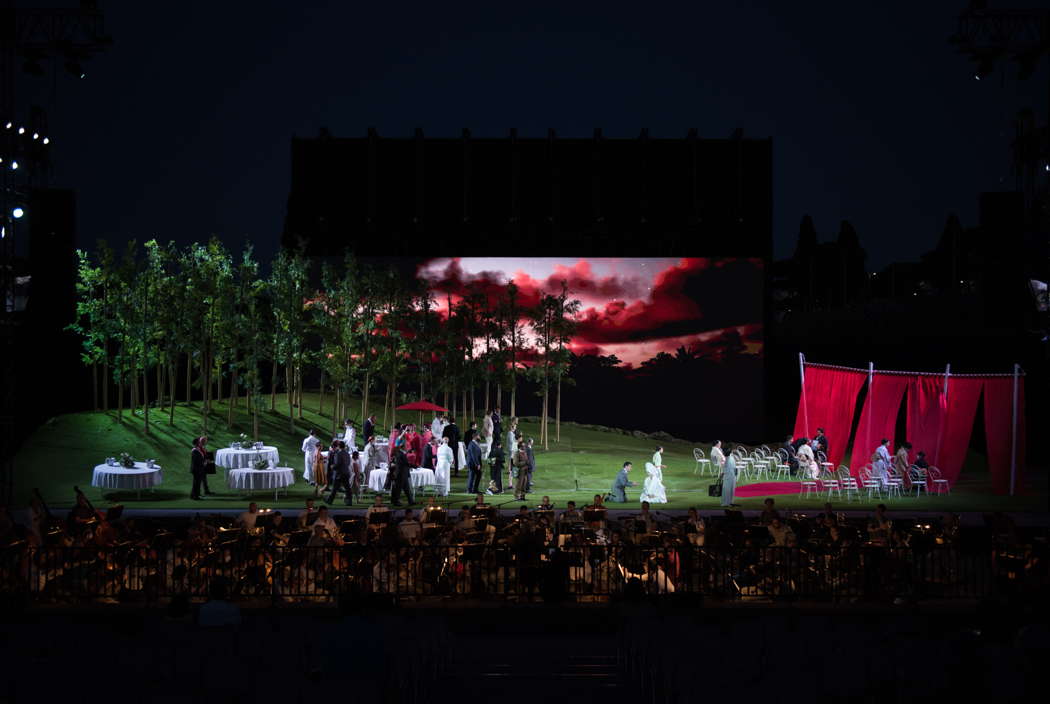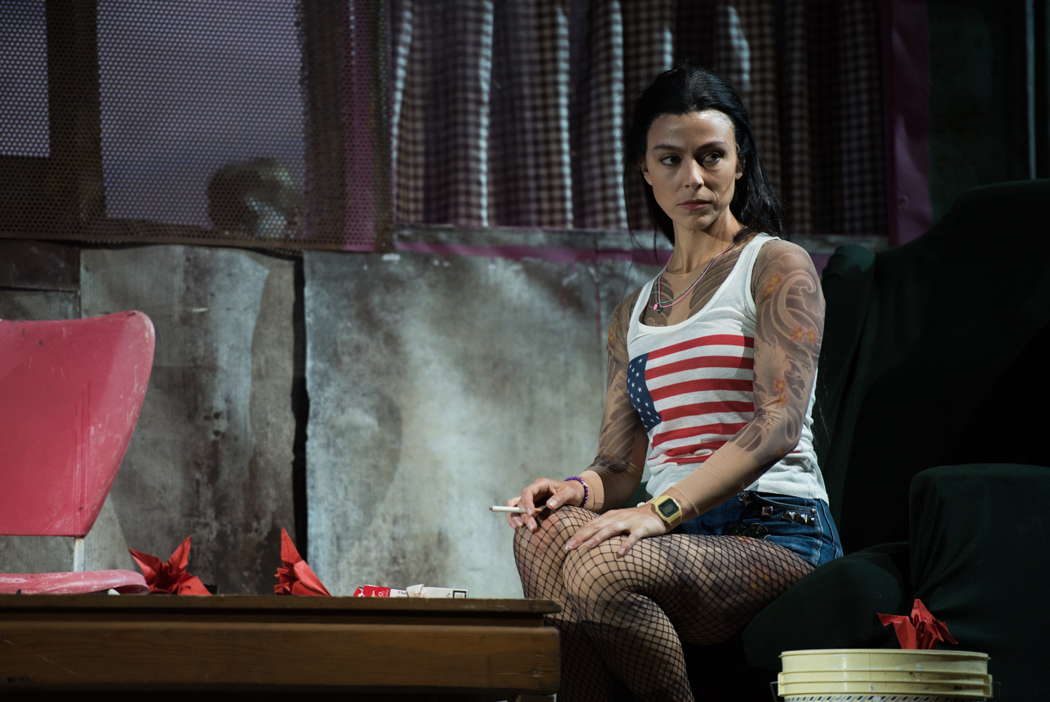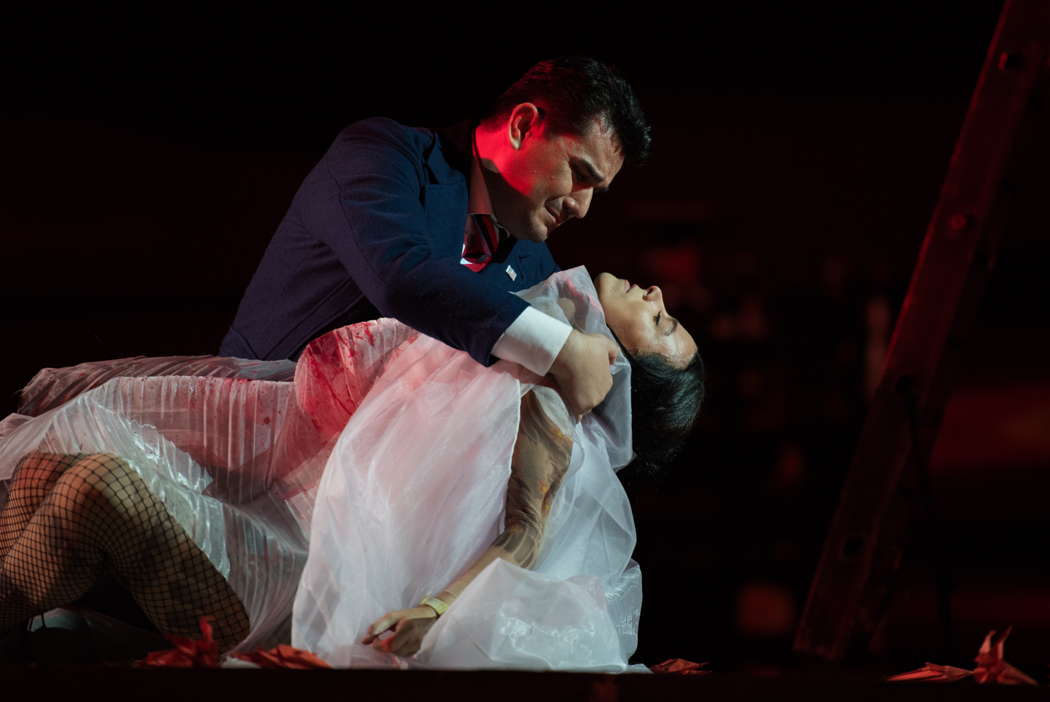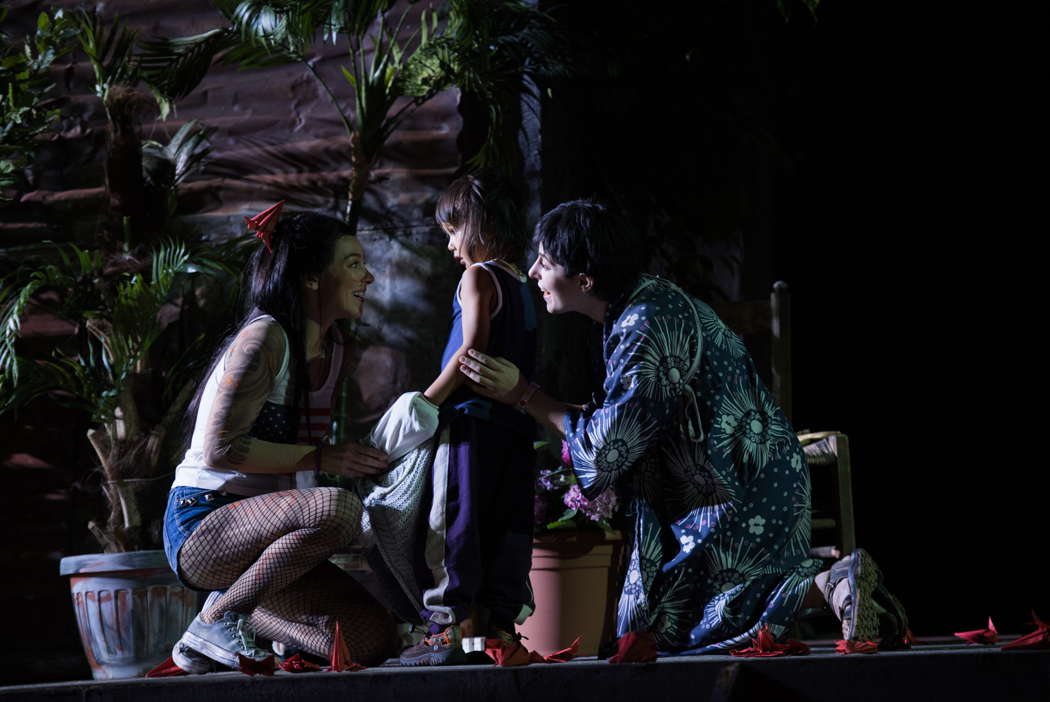- Mozart: The Marriage of Figaro
- Dussek
- Sir Simon Rattle
- James Ross
- Milka Stojanović
- Prokofiev
- Masterworks Chorus of the Palm Beaches
- Clara Warnaar
A Transgressive Butterfly
GIUSEPPE PENNISI was in the audience in Rome
The second opera on the billboard of Teatro dell'Opera di Roma's summer season is Puccini's Madama Butterfly. I was in the audience at the first performance on 16 July 2021, a windy evening that threatened thunderstorms. This is neither a new production nor a revival but a re-staging of a production seen at the Baths of Caracalla in 2015 adapted to the different conditions, especially the huge stage. The theatre was very full as the production, already revived in 2016 at the Baths of Caracalla, had been a huge success whose memory remained alive to the inhabitants of Rome.
In many ways, this is a transgressive production. Not that there are singers who undress and dress on stage, moments of explicit sex or hints of masochism, as we see now in several new opera productions, especially in Germany. The production is, from this point of view, chaste, even in the scene about the intercourse that closes the first act. It is transgressive because it brings the story to the present day and transforms Pinkerton into a nasty person; he goes to Japan in search of sex with minors - Butterfly is fifteen years old in the first act and less than nineteen in the second - but above all to make building speculations. He buys an area on a hill near Nagasaki, with a young girl, a small house and agricultural land, considered as appurtenant goods; he covers the ground with buildings like those in any suburb of a huge town.
The production is much tougher than that created by Damiano Michieletto in 2010 in Bologna and resumed in 2015, as well as seen on the RAI 5 TV channel. Michieletto brought the action to nowadays (or almost) in a shabby housing in Tokyo where Butterfly is little more than a prostitute redeemed by her love for Pinkerton. This production is much tougher because the drama of a girl destroyed by a building speculator is more ferocious than that of a young woman addressed to prostitution since she was a child, according to a use of fallen Japanese families. (Cio-cio-san's father was induced to suicide by a senior member of the Nagasaki establishment.)
The production's general concept is by Catalan avant-garde group La Fura del Baus; the stage direction is by Alex Ollé, the attractive sets by Alfons Flores, the costumes by Lluc Castello and the video by Frank Aleu. Direction, sets and costumes are of great level and far from the most recent productions by La Fura, such as the questionable Forza del destino proposed by the Maggio Musicale Fiorentino and reviewed here on 23 June 2021. As is often the case, Ollé cares little about the singers' acting, so they rely on their experience and sensitivity.

A scene from the Teatro dell'Opera di Roma production of Puccini's Madama Butterfly at the Circo Massimo in Rome. Photo © 2021 Fabrizio Sansoni
Regarding the music, the first comments deserve to go to the orchestra and chorus. Donato Renzetti is a veteran of the score and the Teatro dell'Opera orchestra plays to a very high level. Thanks to the wind from the South West, the orchestral sound came across very well from my seat in row fifteen. It showed the often underestimated richness of the score: a dozen themes that intersect like arabesques in a continuous symphonic tapestry which lead into the admirable night 'interlude' of awaiting Pinkerton's return to Nagasaki. Usually, this interlude is played at the beginning of Act III but in this two-part edition it appears between the first and second scenes of Part 2. The chorus prepared by Roberto Gabbiani was excellent, both in the wedding party and in the sequence 'of closed mouths' or 'humming' presented as a hieratic procession, nearly a funeral march anticipating Cio-cio-san's suicide.
Regarding the cast, there were great expectations for Corinne Winters, a highly appreciated American soprano, who was making her debut both in the role and at the Teatro dell'Opera. She is young, attractive and, like all American sopranos in general, well trained in acting. She is a dramatic soprano with a very pure emission and great vocal extension that in the first part embodies Cio-cio-san the little girl and in the second part the woman who grew up quickly and is faced with difficult choices. She was applauded open scene after 'Un bel dì vedremo' and 'Tu, tu, tu, tu piccolo Iddio'; she had real ovations at the end of the performance.

Corinne Winters in the title role of the Teatro dell'Opera di Roma production of Puccini's Madama Butterfly at the Circo Massimo in Rome. Photo © 2021 Fabrizio Sansoni
At her side, in the role of Pinkerton, was Saimir Pirgu. I have followed him from his first successes, that is, since in 2002 he played the role of Cavalier Belfiore in Il viaggio a Reims at the Rossini Opera Festival and I also had the fortune to be among the audience at one of his concerts at the Tirana Opera House in January 2011. It is admirable how in recent years, he has managed his transition from a coloratura lyric tenor with a lot of high Cs to a tenor whose voice is pivoted on a center register; in short, from Nemorino to Pinkerton and Cavaradossi.

Saimir Pirgu as Pinkerton and Corinne Winters in the title role of the Teatro dell'Opera di Roma production of Puccini's Madama Butterfly at the Circo Massimo in Rome. Photo © 2021 Fabrizio Sansoni
Adriana Di Paola is an effective Suzuki, and Andrzej Filończyk a good Sharpless. The cast is completed by Pietro Picone (Goro), Raffaele Feo (Principe Yamadori), Luciano Leoni (Zio Bonzo) and two young talents from Teatro dell'Opera's 'Fabbrica' Young Artist Program : Sharon Celani (Kate Pinkerton) and Arturo Espinosa (Imperial commissioner). All were of a good level.

Corinne Winters as Cio-cio-san and Adriana Di Paola as Suzuki in the Teatro dell'Opera di Roma production of Puccini's Madama Butterfly at the Circo Massimo in Rome. Photo © 2021 Fabrizio Sansoni
I had just one doubt. The new 'reference score' is used - that is, the 1906 version prepared by Puccini for the Opéra Comique in Paris, which has entered the repertoire, with a series of small additions and adjustments made later by the composer. In 2014, a real rarity was staged in Genoa: the edition that triumphed at the Teatro Grande in Brescia in Autumn 1904 after the real thud at La Scala a few months earlier. Puccini retouched little between the la Scala and Brescia versions. (The outcome at La Scala is largely attributable to the poor production.) He kept the opera in two acts, slightly retouched the orchestration and added the aria 'Addio fiorito asil' for the tenor.
With direction like that by La Fura del Baus it would have been preferable to use the 1904 version. The libretto by Luigi Illica and Giuseppe Giacosa was inspired by the homonymous text in a single act by David Belasco, which Puccini had the opportunity to see in London in 1900. Deeply impressed by the human tragedy of the protagonist, Cio-cio-san, suicidal for love, and fascinated by the exotic setting of Japan, Puccini created one of the most famous heroines of opera. He would have liked to have a 'single act' opera, then in fashion, but the management of La Scala preferred two acts because of the difficulty of finding a second one-act opera with which to stage Madama Butterfly. The Milan version of 1904 was heard at La Scala (where it inaugurated the 2016-2017 season), as well as twice at the Puccini Festival in Torre del Lago, and once at La Fenice and once in Boston. Pinkerton is a racist rascal. Both in the Milan and in the Brescia version, Cio-cio-san is a child aware of her role; in a passage in Act I she says that Pinkerton paid a hundred yen - a large sum - for her and therefore she must do everything to please him. The Milan version of 1904, with its rawness, seems to me more in keeping with the general conception of the 2021 Rome production.
Copyright © 19 July 2021
Giuseppe Pennisi,
Rome, Italy

MORE ARTICLES ABOUT MADAMA BUTTERFLY
MORE CLASSICAL MUSIC ARTICLES ABOUT JAPAN




